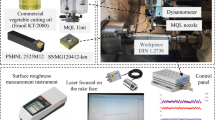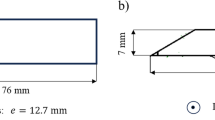Abstract
A tool life test was performed in the conventional (nonorthogonal) cutting mode to determine the effects of cooling schemes, based on the coolant circulation inside an indexable insert body, on cutting tool wear. Two cooling schemes — a Combined Scheme, in which the coolant enters the cutting zone through a channel inside the insert body, and an Internal Scheme, in which the coolant circulates in the channel inside the insert body without entering the cutting zone — were compared with the traditional external cooling and dry cutting. All schemes were performed by using a special (universal) turning tool prototype. The tests were conducted at cutting speeds of 180 m/min and 100 m/min, with a constant feed and depth of cut. The evaluation criteria were (based on ISO standard 3685:1993) flank wear VBb and crater depth KT at a minimum cutting time of 30 min (if the selected wear limit values had not been reached earlier). Additionally, the values of cutting force components and the parameters of the chips (shape, mass, length, etc.) were obtained for each tested scheme. The test results allowed us to draw conclusions not only about the effects of each proposed cooling scheme on the tool wear parameters, but also about the changes in the shear plane angle and shear strain values due to the use of each proposed scheme.



















Similar content being viewed by others
References
Trent EM, Wright PK (2000) Introduction: historical and economic context. Trent EM, Wright PK Metal cutting, 4th edn. Butterworth-Heinemann, Woburn, pp 1–8
Ashby MF (1992) Materials selection in mechanical design. Pergamon Press, Oxford
Abukhshim NA, Mativenga PT, Sheikh MA (2006) Heat generation and temperature prediction in metal cutting: a review and implications for high speed machining. Int J Mach Tools Manuf 46(7–8):782–800. https://doi.org/10.1016/j.ijmachtools.2005.07.024
Jahanbakhsh M, Akhavan Farid A, Lotfi M (2016) Optimal flank wear in turning of Inconel 625 super-alloy using ceramic tool. Proc Inst Mech Eng, Part B: J Eng Manuf 232(2):208–216. https://doi.org/10.1177/0954405416640698
Lan TS, Chuang KC, Chen YM (2018) Optimization of machining parameters using fuzzy Taguchi method for reducing tool wear. Appl Sci 8:1011. https://doi.org/10.3390/app8071011
Sulaiman S, Roshan A, Borazjani S (2013) Effect of cutting parameters on cutting temperature of TiAl6V4 alloy. Appl Mech Mater 392:68–72. https://doi.org/10.4028/www.scientific.net/AMM.392.68
El Baradie MA (1996) Cutting fluids: part I. Characterization. J Mater Process Technol 56(1–4):786–797. https://doi.org/10.1016/0924-0136(95)01892-1
Sreejith PS (2008) Machining of 6061 aluminium alloy with MQL, dry and flooded lubricant conditions. Mater Lett 62(2):276–278. https://doi.org/10.1016/j.matlet.2007.05.019
Jayal AD, Balaji AK (2009) Effects of cutting fluid application on tool wear in machining: interactions with tool-coatings and tool surface features. Wear 267(9–10):1723–1730. https://doi.org/10.1016/j.wear.2009.06.032
Sanchez LEA, Scalon VL, Abreu GGC (2011) Cleaner machining through a toolholder with internal cooling. 3rd International Workshop Advances in Cleaner Production, Brazil
Isik Y, Kus A, Coskun S, O¨zdemir K, Cakir MC (2017) A novel approach to use internally cooled cutting tools in dry metal cutting. Indian J Eng Mater Sci 24:239–246
Sun X, Bateman R, Cheng K, Ghani SC (2012) Design and analysis of an internally cooled smart cutting tool for dry cutting. Proc Inst Mech Eng, Part B: J Eng Manuf 226(4):585–591. https://doi.org/10.1177/0954405411424670
Shu S, Zhang Y, He Y, Zhang H (2021) Design of a novel turning tool cooled by combining circulating internal cooling with spray cooling for green cutting. J Adv Mech Des Syst Manuf 15:1. https://doi.org/10.1299/jamdsm.2021jamdsm0003
(2019) Cutting tools 2020-2021 (Catalogue), Mitsubishi Materials, C009B. https://www.mmc-carbide.com/en_jp/download/catalog/catalog
(1990) Properties and selection: irons steels and high performance alloys, ASM Handbook, vol 1. ASM International, Russell Township
(1993) Tool-life testing with single-point turning tools, ISO 3685, 2nd edn. International Organization for Standardization ISO Central Secretariat, Geneva
Trent EM, Wright PK (2000) Heat in metal cutting. Trent EM, Wright PK Metal cutting, 4th edn. Butterworth-Heinemann, Woburn, pp 97–130
Trent EM, Wright PK (2000) The essential features of metal cutting. Trent EM, Wright PK Metal cutting, 4th edn. Butterworth-Heinemann, Woburn, pp 21–55
Trent EM, Wright PK (2000) Coolants and lubricants. Trent EM, Wright PK Metal cutting, 4th edn. Butterworth-Heinemann, Woburn, pp 311–337
Daymi A, Boujelbene M, Ben Salem S, Hadj Sassi B, Torbaty S (2009) Effect of the cutting speed on the chip morphology and the cutting forces. Comput Mater Sci Surf Eng 1(2):77–83
Acknowledgements
The authors would like to express their gratitude for the financial support provided by the Japanese Ministry of Education, Culture, Sports, Science, and Technology. We also wish to thank the Mitsubishi Materials Corporation for supplying the cutting tools, assisting in the production of prototypes, and working in collaboration with us.
Funding
Partial financial support was received from the Japanese Ministry of Education, Culture, Sports, Science, and Technology and from the Mitsubishi Materials Corporation.
Author information
Authors and Affiliations
Contributions
Ilia Radchenko performed the experiment, and the data analysis, and wrote the manuscript. Wataru Takahashi and Hidebumi Takahashi provided technical support. Hiroyuki Sasahara contributed to the study by supervising.
Corresponding author
Ethics declarations
Competing interests
The authors declare no competing interests.
Additional information
Publisher's Note
Springer Nature remains neutral with regard to jurisdictional claims in published maps and institutional affiliations.
Rights and permissions
Springer Nature or its licensor (e.g. a society or other partner) holds exclusive rights to this article under a publishing agreement with the author(s) or other rightsholder(s); author self-archiving of the accepted manuscript version of this article is solely governed by the terms of such publishing agreement and applicable law.
About this article
Cite this article
Radchenko, I., Takahashi, W., Takahashi, H. et al. Effects of internal coolant circulation-based cooling schemes on tool wear in turning SUS304 stainless steel. Int J Adv Manuf Technol 129, 3141–3154 (2023). https://doi.org/10.1007/s00170-023-12474-y
Received:
Accepted:
Published:
Issue Date:
DOI: https://doi.org/10.1007/s00170-023-12474-y




